
FLORA & FAUNA MÉXICO
Mexico´s Flora & Fauna
Mexico is considered one of 17 mega diverse countries in the world. These are a group of countries that contain the majority of the Earth’s species and are therefore considered extremely biodiverse. The most important causes of megadiversity in Mexico are its topography, its variety of climates and its complex geological, biological and cultural history. All these important factors have contributed to the formation of a mosaic of environmental conditions that enabled the evolution of a large variety of habitats and life forms, many of which are endemic (unique to Mexico).
With over more than 200.000 different species, Mexico is home to 10 – 12% of the entire world’s biodiversity. Mexico ranks first in biodiversity in reptiles with 707 known species, second in mammals with 438 species, fourth in amphibians with 290 species, and fourth in flora, with 26,000 different species. Mexico is also considered the second country in the world in ecosystems and fourth in overall species.
The peculiarities of Mexican wildlife:
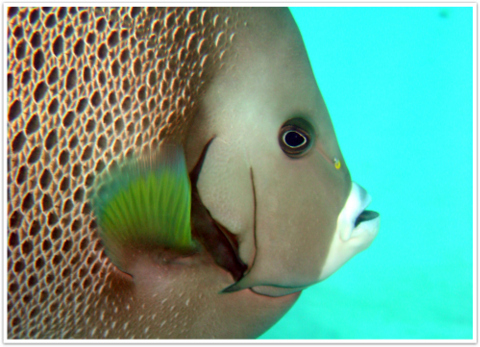 Marine Life
Marine Life
With over 5,700 km of coastline Mexico has an extraordinary amount of marine life to observe. There are over 15,000 different species of marine life found in the Gulf of Mexico alone and cover everything from mammals, fish, invertebrates, sea plants, corals and plankton. The Belize Barrier Reef which is the 2nd largest reef in the world runs along the Yucatan Peninsula and around the Island of Cozumel and Isla Mujeres. Here you can find large numbers of exotic tropical fish such as the green humphead parrotfish, the graysby and spotted scorpionfish. The warm waters are crystal clear and extremely pleasant for snorkeling and diving year round. There are many protected reefs in Mexico which provide shelter for the sea turtles, sharks, dolphins, rays, tropical fish and colourful coral, sea grasses and sponges.
To the daytrip: Sailing and snorkeling at Isla Mujeres
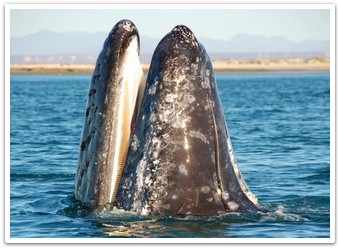 Whales
Whales
There are a number of whale species found throughout Mexico. In the Northern sections of Baja California and the Pacific Coast the humpack, gray, fin and blue whales migrate away from the cold artic waters every year between November and March. The humpback whale is a highly migratory species which travels in small groups and arrives in Mexico to feed and breed. The males arrive first, followed by the pregnant females. Mid way through the season the calves are born and grow to a sufficient size before making their way back North. The humpback whale is one of the only large whale species to hunt in a group. The whales blow bubble around schools of fish and these “bubble nets” trap the fish while the whales take turns diving into the swarm to feed. The amazing acrobatic behavior of the humpback whale is what makes them such an exciting species to observe. They can frequently be seen breaching high out of the water, creating quite a splash and making for great photo opportunities.
To the trip: Baja California
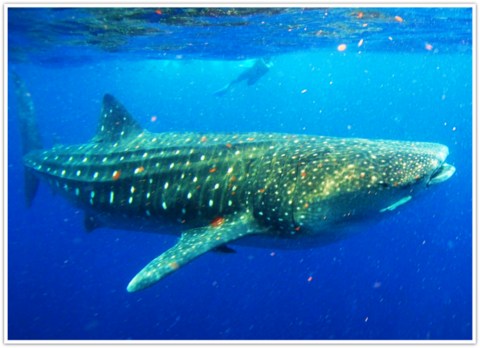 Whale Sharks
Whale Sharks
Not a whale nor a shark as the name suggests, but rather the largest species of fish in the world. Whale sharks are a filter feeding fish and are characterized by their wide mouth and spotted back. These gentle giants feed mostly on plankton and on average are as large as 10-12 m and weigh around 10 tons. Off the island of Holbox in Mexico you have the opportunity to snorkel and dive with whale sharks between May and September. Whale sharks are very friendly and the young love to play with divers. In 2011 over 400 whale sharks gathered off the Yucatan Coast in an event that to this day still puzzles scientists.
To the daytrip: Riviera Maya – Snorkel with Whale Sharks
 Sea Turtles
Sea Turtles
In total there are seven species of sea turtle in the world. Six of these migrate to Mexico to lay their eggs every year. For the most part sea turtles live their lives and mate at sea, only returning to land to lay their eggs. The females return to exactly the same place where they were born. Scientists believe they use the Earth´s magnetic field to coordinate the return. Between June and November sea turtles can be found in Akumal, Rio Lagartos, San Jose del Cabo, Cabo San Lucas, Oaxaca, Manzanillo, Puerto Vallarta, Costa Alegre and Mazatlan. A female will lay up to 200 eggs at a time and when it is time to hatch the little babies must make their way to the sea. The Mexican government and many Conservation Agencies have protected sanctuaries where the sea turtles can lay their eggs far away from the risk of poachers and predators in an effort to protect this endangered species.
To the daytrip: Snorkel Akumal & Cenote
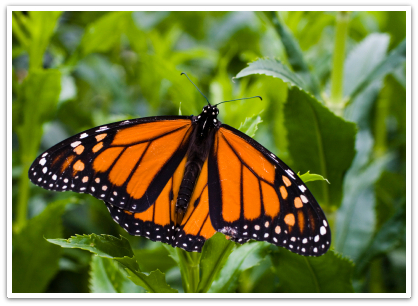 Monarch Butterflies
Monarch Butterflies
The monarch butterfly migration in Mexico every year is a remarkable event and a must see experience if travelling in Mexico between October and March. Every year between 60 million and 1 billion monarchs travel more than 4,000 km and spend the winter in central Mexico. The Monarch Butterfly Biosphere Reserve located in the state of Michoacan and the state of Mexico is a UNESCO world heritage site covering 56,000 hectares and is dedicated to the protection of the monarchs as well as their habitat. The butterflies congregate in clusters on the pine and oyamel trees in clusters so large the trees appear orange and the branches sag under the weight of the butterflies. When they take flight to mate the sky fills with clouds of butterflies and the flapping of their wings sounds like a soothing light rain
To the daytrip: Monarch Butterflies in Valle de Bravo
Exotic Birds:
Mexico is home to over 1,000 different bird species. It is a bird lover’s paradise and with so many different ecological zones there is a wonderful variety of species, many which are only found in Mexico.
Hummingbirds
These tiny and colourful birds can be found throughout Mexico. There are approximately 60 different species of hummingbirds found in Mexico and 15 of these are endemic. Some of the hummingbird species make seasonal migrations based on the patterns and abundance of flowering species.
Resplendent Quetzal
The resplendent quetzal is a beautiful species of the trogon family and is characterized by its bright green colour and long tail feathers. The word “quetzal” comes from the Aztec language Nahuatl and was worshiped by the Maya and Aztec civilizations as the God of Air. It´s iridescent green feathers represent spring plant growth and it´s long tail feathers were used by rulers on headdresses, symbolically connecting them to the Creator God Queztalcoatl. They are solitary birds which feed mostly on fruit and can be found in the mountain cloud forests of Southern Mexico.
American Flamingo
This is the only flamingo which naturally inhabits North America and can be found in Mexico in the Petenes mangrove region of the Yucatan Peninsula, specifically Rio Lagartos and Celestun. Their numbers are highest between April and July, however non breeding flamingoes can be found year round. These unique birds have long legs developed for wading in the shallow waters of the mangrove swamps and a soft pink colour from eating crab and shrimp larvae. The American flamingo is slightly smaller than other flamingo species and ranges from 120-150cm in height and between 2.2-2.8kg. Their beak contains a salt gland which helps to regulate and release the large contents of salt in their high saline diet. They also have one of the longest life spans of birds and can live up to 40 years.
To the daytrip: Flamingos in Celestún
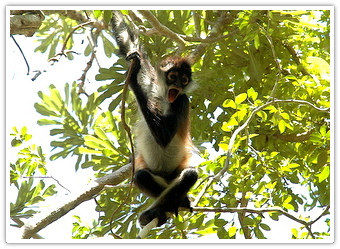 Spider Monkey
Spider Monkey
The spider monkey is a new world monkey of the ateles genus and can be found in the jungles of southern Mexico. They live in the high canopy of the jungles foraging for fruit between 25-30m above the jungle floor. They are highly social animals and live in groups of around 30 members, though they tend to forage individually. They are characterized by their disproportionately long limbs and long prehensile tail. Spider monkeys are quite noisy and come alive when anyone or anything enters their territory. The loud calls and screeches can carry up to 1,000m on the ground and 2,000 in the jungle canopy.
To the daytrip: Yaxchilan & Bonampak
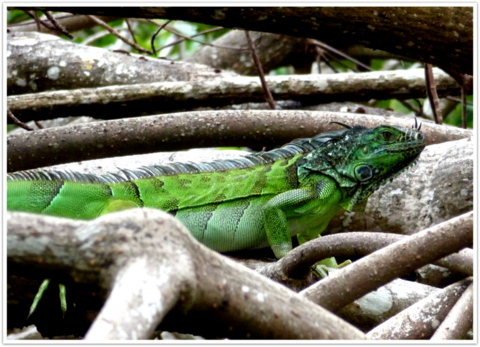 Spiny tailed Iguana
Spiny tailed Iguana
This is a moderate sized iguana endemic to Western Mexico from Sinaloa through Oaxaca and Chiapas. They inhabit lowland dry forests and prefer rocky landscapes where they can hide in crevices. They are excellent climbers and can be found in trees. They are normally brown and grey and can be difficult to spot as they easily blend in to their environment. Contrary to other iguana species, the spiny-tailed iguana is a social animal and can be found in groups, normally basking in the sun. They are generally herbivores, but will eat arthropods or sea turtle eggs if the opportunity presents itself. Hunting and trapping these iguanas is illegal throughout Mexico, though in rural areas they are used as a food source.
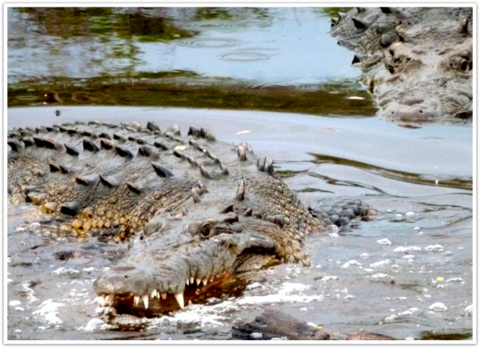 American Crocodile
American Crocodile
The American crocodile is an endangered species found in Southern Mexico. They thrive in the fresh or brackish water of river estuaries, coastal lagoons and mangrove swamps. A prehistoric looking animal they can grow up to 6m long and are quite an imposing animal when seen up close. Despite their large size they do not normally attack mammals and prefer to eat fish, reptiles, birds and small mammals.
Zur Tagestour: Canyon del Sumidero
Donkey
The jaguar which is an important symbol of pre-colombian cultures is currently an extremely endangered animal. In Mexico they can only be found in small, isolated locations throughout the country such as Sonora, Campeche and Tabasco, specifically in the region of the Terminos Lagoon, one of the largest wetlands in the country. The jaguar is a solitary opportunistic stalk and ambush apex predator. They are at the top of the food chain and have an exceptionally powerful bite. A colour morphism occurs in jaguars. 6% of jaguars are born with melanism and appear entirely black, though upon close inspection the spots can be seen. There is much cooperation between the Mexican government and a number of Conservation Agencies to try and prevent the loss of habitat and poaching of these magnificent big cats.
Esel
The noble donkey, in Mexico called the burro, is a hard working animal and a common site in central Mexico. The total donkey population in Mexico is over 3 million making it one of the largest in the world, though this number is rapidly declining as farmers are moving into the cities and away from rural life. The Mexican donkey tends to be smaller than other donkey varieties, but that does not take away from their usefulness in Mexican society. Donkeys are used in rural areas to carry supplies, plow fields and draw up water.
Venomous Species:
Mexico is home to a number of venomous animals such as spiders, snakes, insects, octopus and scorpions which can be found throughout the country. Here are a few of the most deadly:
Coral Snake
In Mexico there are two highly poisonous snakes. The first being the coral snake which can be found throughout Mexico. They are easily distinguishable by their red, yellow/white and black bands. There are 60 species of coral snake found in Mexico and all are poisonous. The coral snake is often referred to by locals as the 20 minute snake because if medical attention is not received within 20 minutes the chances of survival are very slim. These are extremely reclusive animals which live in sparsely populated areas and rarely come into contact with humans.
Rattlesnake
Another highly poisonous animal this snake is typically found in the mountainous arid and semi arid regions of central and northern Mexico. The Mexican west coast rattlesnake is recognized for its large size and potent venom. Specimens exceeding 150 cm are not uncommon and are generally a brown or grayish colour with their distinctive tail which will move making a rattling noise if threatened.
Scorpions
Scorpions can be found throughout Mexico and have a prehistoric looking quality that creates a fear that is unwarranted. Of the 221 species of scorpions that exist in Mexico only 8 can seriously harm you. The dangerous species are located in the states of Durango and the coastal regions of Jalisco, Nayarit, Colima and Michoacán. Scorpions are nocturnal and usually hide in cool places during the day. It is advisable to check your shoes in the morning before putting them off if you are travelling in these areas.
A short description of our Mexican Flora:
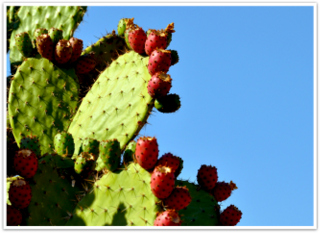 Cactus
Cactus
Mexico is famous for its cacti and with the majority of the Northern section of the country being extremely arid it is no wonder the quantity of these majestic species. There are approximately 900 different types of cactus found in Mexico representing 45% of the total world’s cacti diversity. The most common being cardon, saguaro, barrel, organ pipe and prickly pear. Not only are they beautiful, but also edible. Cactus can be grilled, sautéed, put in smoothies and you can also eat the fruit of some species such as that which grows on the prickly pear.
 Bugambilia
Bugambilia
This climbing shrub with thorny stems is found throughout Mexico and is synonymous with the colorful culture found in this beautiful country. It usually grows between 3 – 4 m tall and the flowers can be pink, purple, white, orange or yellow. They are often used for covering walls or roofs due to their climbing properties where they spill over in beautiful waterfalls of colorful flowers. They thrive in this sunny climate and do not need a lot of water.
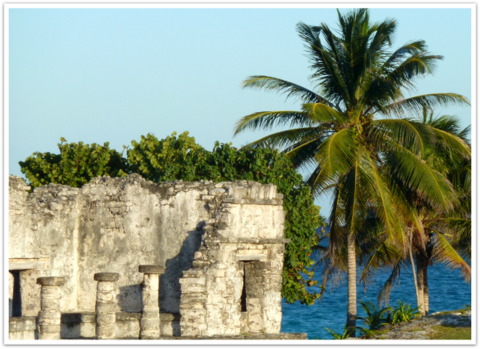 Palm Trees
Palm Trees
Palm trees are a very resilient plant and grow throughout Mexico. They can be found in the tropical wet ecological zones as well as the arid deserts in the North. Palm trees vary from tall trees such as the royal palm which is characterized by its straight white trunks and can grow up to 30m high to smaller more bush like plants such as the guano palm which is used as roofing material by the Maya. Some palms bear fruit such as the coconut palm and others are used for their medicinal purposes such as the dwarf saw palmetto.
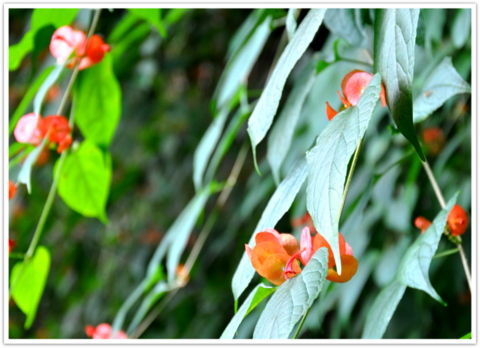 Orchids
Orchids
Orchids represent all that is beautiful and exotic in the plant world. These delicate plants can be found in Mexico growing on the ground, over trees and rocks and thrive in both arid and subtropical regions. In order to flower successfully orchids need a significant variation in daytime and night time temperatures as well as a climate that has wet and dry periods. They can grow as large as a tree or be as small as a pin head. With over 30,000 orchid species found in nature it is a very diverse flower and a beautiful example of Mexico´s flora.




